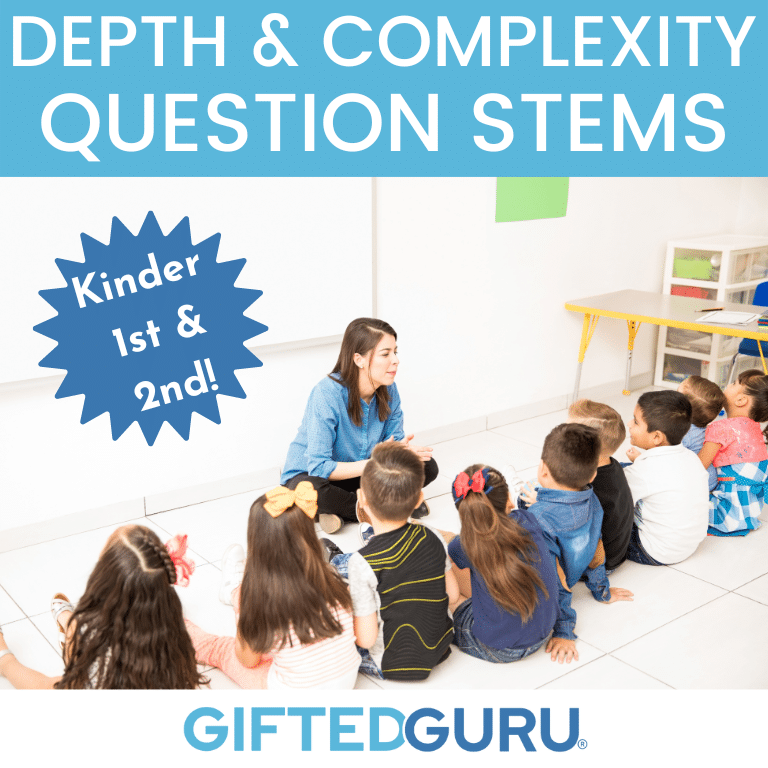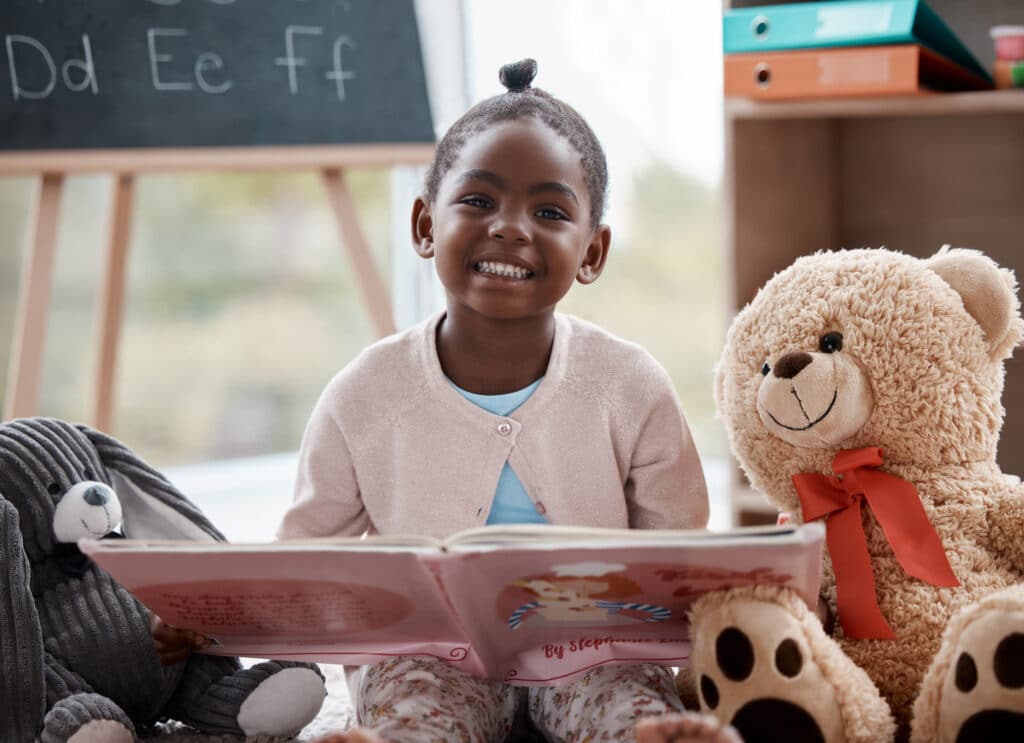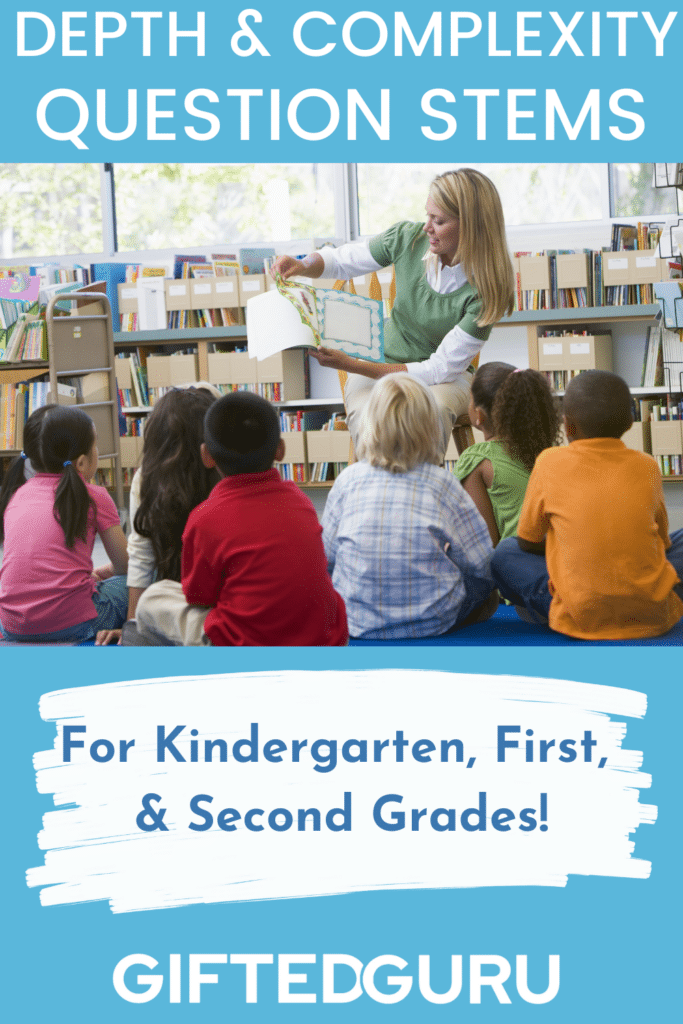If you teach littles and have wondered what Depth and Complexity looks like with Kindergarten, First, or Second Grades, I’ve got a list of question stems to get you started.
Depth and Complexity is about what students are thinking, not what they’re doing, so focusing on questions is the best way to begin using the framework!
I’ve separated the questions into content area sections, and I’ve indicated the Depth and Complexity thinking prompt with the emoji I use (read more about that in this article) as well as putting the name of the prompt in parentheses after the question.
✅ All the science question stems address Next Generation Science Standards for Kindergarten.
✅ All the ELAR questions address CCSS standards and also align with DOK.
✅ One thing you may notice is that tools, equipment, symbols, and people are 👄 Language of the Discipline. That can throw people, so keep your eye out!
✅ You’ll also notice that there may be multiple ways to approach a question. Sometimes I’ve just picked a thinking prompt, and other times I’ve explained why two different prompts might work.
ELAR DEPTH & COMPLEXITY QUESTION STEMS
- Name one important 🍃 detail about the story. Where in the story does it say that? (Details)
- Who are the 🍃 characters in this book? (Details)
- What are 🍃 three things we know about this character? (Details)
- What does 🕶️ this character think about what happened? (Multiple Perspectives) 🍃How do we know? (Details)
- How did they solve the ⚖️ big problem in the story? (Ethics)
- How was the story different at the ⏳ end than it was at the beginning? (Change over Time OR 🌀 Patterns, if the story doesn’t take place over a long period of time and you want to emphasize a pattern shift or the plot sequence)
- If the big problem in this story were a 📚 color, what color would it be? (Across Disciplines)
- How is 📉 character x different from character y? (Trends)
- 🍃 Who is talking in the story? (Details)
- How does the picture/illustration 🌳 help the reader understand what is happening? (Big Idea)
- Is this a 👄 drawing or is it a photograph? (Language of the Discipline)
- How would the story be different if 🕶️ [some character] was telling the story? (Multiple Perspectives)
- How do you know what this 👄 word means? (Language of the Discipline)
- What does the 👄 author of a story do? (Language of the Discipline)
- The story 🍃 says _____________________. Where do you see that in the 📚 illustrations? (Across Disciplines)
- Who would ❓ make a better president, this character or that character? (Unanswered Questions)
- 🌳 Why do you think the author wrote this story? What is he/she hoping we will think after we read it? (Big Idea)
- What’s another 👄 word the author could have used that means the same thing? )Language of the Discipline)
- 🌳 How is the moral of this story 🌀 similar to the moral of that story? (Big Idea)
MATH DEPTH & COMPLEXITY QUESTION STEMS
- What would you do to solve this problem ⏳ again? (Change over Time OR Multiple Perspectives if you want to emphasize that people could approach it differently)
- Why did 🕶️ you decided to do ___________? (Multiple Perspectives)
- What does this 👄 symbol represent? (Language of the Discipline)
- How 🍃 did you prove your estimate was correct? (Details)
- How are 👄 adding and subtracting similar? (Language of the Discipline)
- What would happen if you 🚦 added 2 tens to the number 15? (Rules)
- 📚 Draw four circles. Draw five more. 🚦 How many circles do you have? (Across Disciplines and Rules)
- What 🌀 pattern did you notice when you wrote these addition problems? (Pattern)
- What are the most important 🍃 details in this problem? (Details)
- 🌳 Why is it important to know how to solve this type of problem? (Big Idea)
- How is this problem ❓ like a thunderstorm? (Unanswered Questions)
- Are these problems 📉 getting more interesting, less interesting, or staying the same? (Trends)
- Does the equals sign 🕶️ like addition better or subtraction? (Multiple Perspectives)
- What is something in this problem that is 🌀 similar to the other problem? Do you think you could solve it the same way? (Patterns)
SCIENCE DEPTH & COMPLEXITY QUESTION STEMS
- How did your 📚 drawing help show how the shape of the object helped it solve the problem? (Across Disciplines)
- How did this new 👄 tool help solve the problem? (Language of the Discipline)
- Why do deer 🚦 usually live in meadows? (Rules because usual behavior is Rules.) 🍃 What is there that they need? (Details)
- What are three possible 📉 consequences of people not throwing plastic in the water? (Trends)
- Why do we 🌀 forecast the weather? Patterns) How do we 🌀 prepare for bad weather?
- What kind of bad weather do 🕶️ you like the least? The most? (Multiple Perspectives)
- If you see super dark clouds in the sky, what can you 🌀 predict might happen? (Patterns)
- What are some things all living things 🚦 need? (Rules)
- 👄Weather is a combination of ______________, _____________, ________________, and __________________ in a particular place at a particular time. (Language of the Discipline)
- When they 📉 put wolves back into Yellowstone National Park, they changed the rivers. What caused this to happen? (Trends)
- Why do we measure and record the weather ⏳ over time? (Change over Time; the answer is Patterns)
- How is what humans need to survive 🌀 similar to what plants need to survive? (Patterns)
- What does sunlight 🚦 do to the Earth’s surface? If you wanted an area to be cooler, what could you 🚦 do to make that happen? (Rules)
- ❓ What would happen if [insert name of animal] became extinct? (Unanswered Questions)
- What would be the ❓ best tool to use to do this task? (Unanswered Questions)
- Explain 🍃 why it rains to 🕶️ someone who hates rain. (Details and Multiple Perspectives)

SOCIAL STUDIES DEPTH & COMPLEXITY QUESTION STEMS
- What are three 🍃 things that make holidays special? (Details)
- Which is more useful to a 🕶️ driver, a map or a globe? (Multiple Perspectives)
- Are people controlled by 🚦 rules, or do people control the rules? (Rules)
- Why do people need to be ⚖️ responsible for their actions? (Ethics)
- If I said that 🍃 everyone is unique, why would you agree or disagree with me? (Details)
- Why do people need to be ⚖️ global citizens? (Ethics)
- How can we learn about ⏳ the past through family stories? (Change over Time)
- What are three ⚖️ bad choices people can make with their money? Good choices? (Ethics)
- ❓ How can the things that make us different from each other bring us closer together? (Unanswered Questions)
- If someone said the 🕶️ president was the most important person in government, would you agree or disagree? (This question can be approached through the lens of Rules [government structure], but it can also be approached through Multiple Perspectives [it depends upon whom you asked and what their role/relationship is])
- Why do we need 🚦 rules? What are three reasons we need 🚦 them now that we didn’t have a ⏳ long time ago? (Rules and then Rules + Change over Time)
- Why do we care about what ⏳ happened a long time ago when we live now? (Change over Time)
- If you had to pick a 👄 symbol to represent the United States, what would you pick? (Language of the Discipline)
- Humans impact the environment, and the environment impacts us. Which impact is 📉 greater, ours on the environment or the environment’s impact on us? (Trends)
- How would your life be 🍃 different if you lived in a different place? (This question can be approached through the lens of Details if you look at details about where you live versus the other place. It can also be approached through the lens of Trends if you are using a straightforward compare and contrast approach.)
Wrapping Up
Depth and Complexity is no more or less complicated than writing strong questions. I hope this list of question stems for younger students has given you some ideas for your classroom.
Learn More
- If you’d like to learn more about the Depth and Complexity framework, here’s the hub for information.
- I’ve written an entire Question Stems eBook you can learn more about here.
- Master Depth & Complexity with the course on it, chock full of great information! Learn more about the course.








